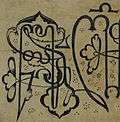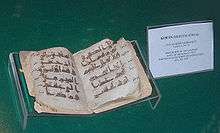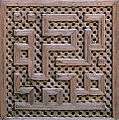Kufic
.jpg)
Kufic is the oldest calligraphic form of the various Arabic scripts and consists of a modified form of the old Nabataean script. Kufic developed around the end of the 7th century in Kufa, Iraq, from which it takes its name, and other centres.[1]
Usage

Kufic was prevalent in manuscripts from the 7th to 10th centuries.[2] Until about the 11th century it was the main script used to copy the Qur'an.[1] Professional copyists employed a particular form of kufic for reproducing the earliest surviving copies of the Qur'an, which were written on parchment and date from the 8th to 10th centuries.[3]
Ornamental use
Kufic is commonly seen on Seljuk coins and monuments and on early Ottoman coins. Its decorative character led to its use as a decorative element in several public and domestic buildings constructed prior to the Republican period in Turkey.
The current flag of Iraq (2008) includes a kufic rendition of the takbir. Similarly, the flag of Iran (1980) has the takbir written in white square kufic script a total of 22 times on the fringe of both the green and red bands.
Square or geometric Kufic is a very simplified rectangular style of Kufic widely used for tiling. In Iran sometimes entire buildings are covered with tiles spelling sacred names like those of God, Muhammad and Ali in square Kufic, a technique known as banna'i.[4]
"Pseudo-Kufic", also "Kufesque", refers to imitations of the Kufic script, made in a non-Arabic context, during the Middle Ages or the Renaissance: "Imitations of Arabic in European art are often described as pseudo-Kufic, borrowing the term for an Arabic script that emphasizes straight and angular strokes, and is most commonly used in Islamic architectural decoration".[5]
| Part of a series on |
| Arab culture |
|---|
 |
| Calligraphy |
|---|
Gallery
 Page from a Qur'an in Kufic style, 8th century (Surah 15: 67–74)
Page from a Qur'an in Kufic style, 8th century (Surah 15: 67–74) Kufic script from an early Qur'an manuscript, 8th-9th century. (Surah 7: 86–87)
Kufic script from an early Qur'an manuscript, 8th-9th century. (Surah 7: 86–87) Manuscript of the Surat Maryam of the Qur'an; Kufic script on gazelle skin, 9th century. (Surah 19: 83–86).
Manuscript of the Surat Maryam of the Qur'an; Kufic script on gazelle skin, 9th century. (Surah 19: 83–86). The leaves from this Qur'an written in gold and contoured with brown ink have a horizontal format. (9th century)
The leaves from this Qur'an written in gold and contoured with brown ink have a horizontal format. (9th century) Bowl with Kufic Inscription, 9th century - Brooklyn Museum
Bowl with Kufic Inscription, 9th century - Brooklyn Museum Bowl with Kufic Calligraphy, 10th century - Brooklyn Museum.
Bowl with Kufic Calligraphy, 10th century - Brooklyn Museum.
.jpg) 11th-century gold Fatimid armlet, inscribed with good wishes in the Kufic script, (Syria).
11th-century gold Fatimid armlet, inscribed with good wishes in the Kufic script, (Syria). Kufic alphabet, from Fry's Pantographia (1799)
Kufic alphabet, from Fry's Pantographia (1799)
 Geometric Kufic from the Bou Inania Madrasa (Meknes); the text reads بركة محمد or barakat muḥammad, i.e. Muhammad's blessing.
Geometric Kufic from the Bou Inania Madrasa (Meknes); the text reads بركة محمد or barakat muḥammad, i.e. Muhammad's blessing. Another example of geometric or square Kufic script, showing four instances of the name Muhammad; often used as a tilework pattern in Islamic architecture
Another example of geometric or square Kufic script, showing four instances of the name Muhammad; often used as a tilework pattern in Islamic architecture Inscription in Kufic (743). The Walters Art Museum.
Inscription in Kufic (743). The Walters Art Museum.- Banna'i on a minaret – a repetitive pattern of square Kufic inscriptions.
 Drawing of an inscription of Basmala in Kufic script, 9th century. The original is in the Islamic Museum in Cairo (Inventar-Nr. 7853)
Drawing of an inscription of Basmala in Kufic script, 9th century. The original is in the Islamic Museum in Cairo (Inventar-Nr. 7853) The flag of Iraq (2008)
The flag of Iraq (2008) The flag of Iran (1980)
The flag of Iran (1980)
See also
Notes
- 1 2 "Arabic scripts". British Museum. Retrieved 13 March 2013.
- ↑ ؟
- ↑ "The Spirit of Islam: Experiencing Islam through Calligraphy". UBC Museum of Anthropology. Retrieved 13 March 2013.
- ↑ Jonathan M. Bloom; Sheila Blair (2009). The Grove encyclopedia of Islamic art and architecture. Oxford University Press. pp. 101, 131, 246. ISBN 978-0-19-530991-1. Retrieved 4 January 2012.
- ↑ Mack, p.51
References
- Mack, Rosamond E. Bazaar to Piazza: Islamic Trade and Italian Art, 1300–1600, University of California Press, 2001 ISBN 0-520-22131-1
- Wolfgang Kosack: Islamische Schriftkunst des Kufischen. Geometrisches Kufi in 593 Schriftbeispielen. Deutsch – Kufi – Arabisch. Christoph Brunner, Basel 2014, ISBN 978-3-906206-10-3.
External links
| Wikimedia Commons has media related to Arabic calligraphy/Styles/Kufic. |
- Square Kufic lectures: alphabet (stylized), examples, square designs
- Kufic manuscript alphabet
- On The Origins Of The Kufic Script
- Kufic Script
- Square Kufic Script
- Square Kufic
- Square Kufic explained